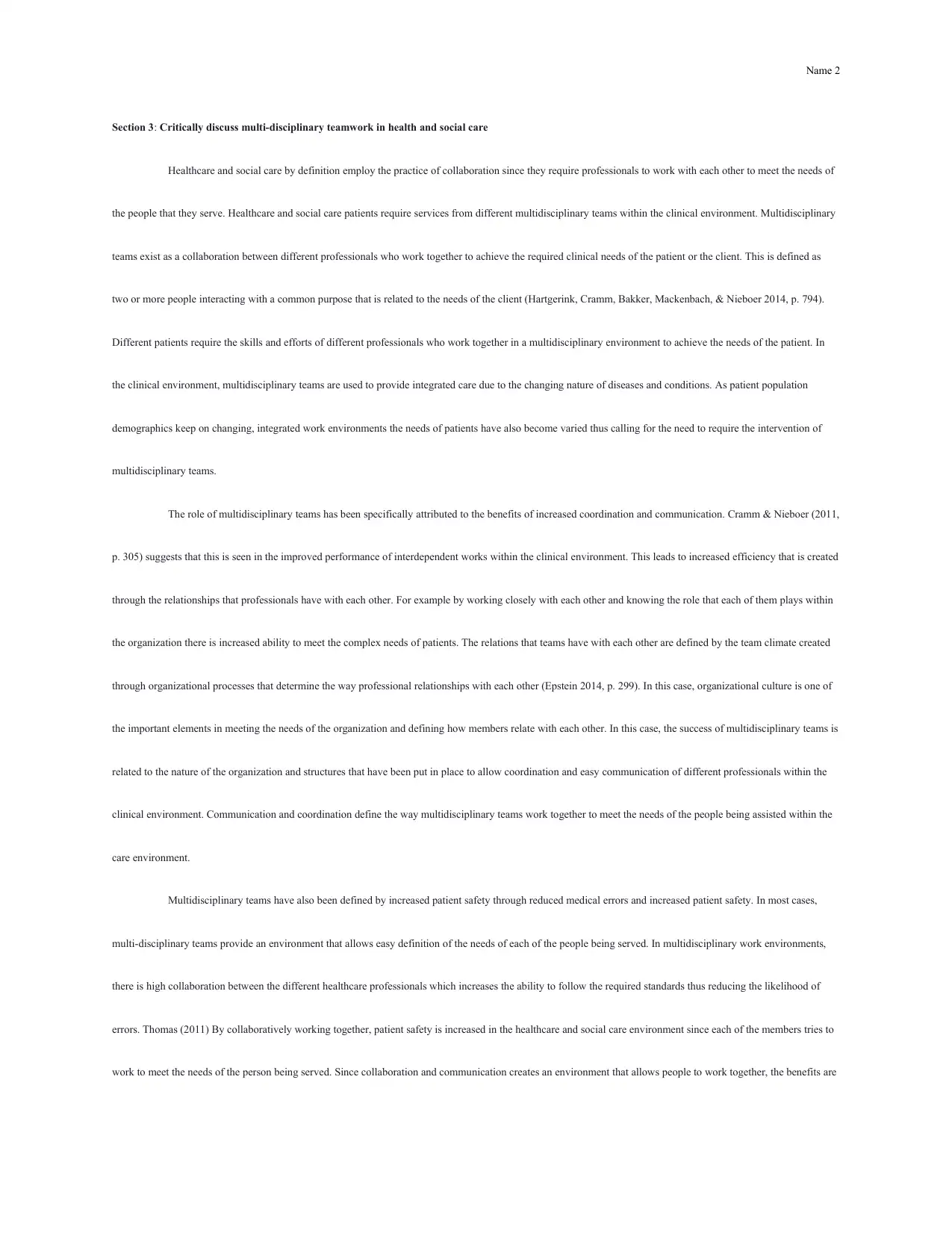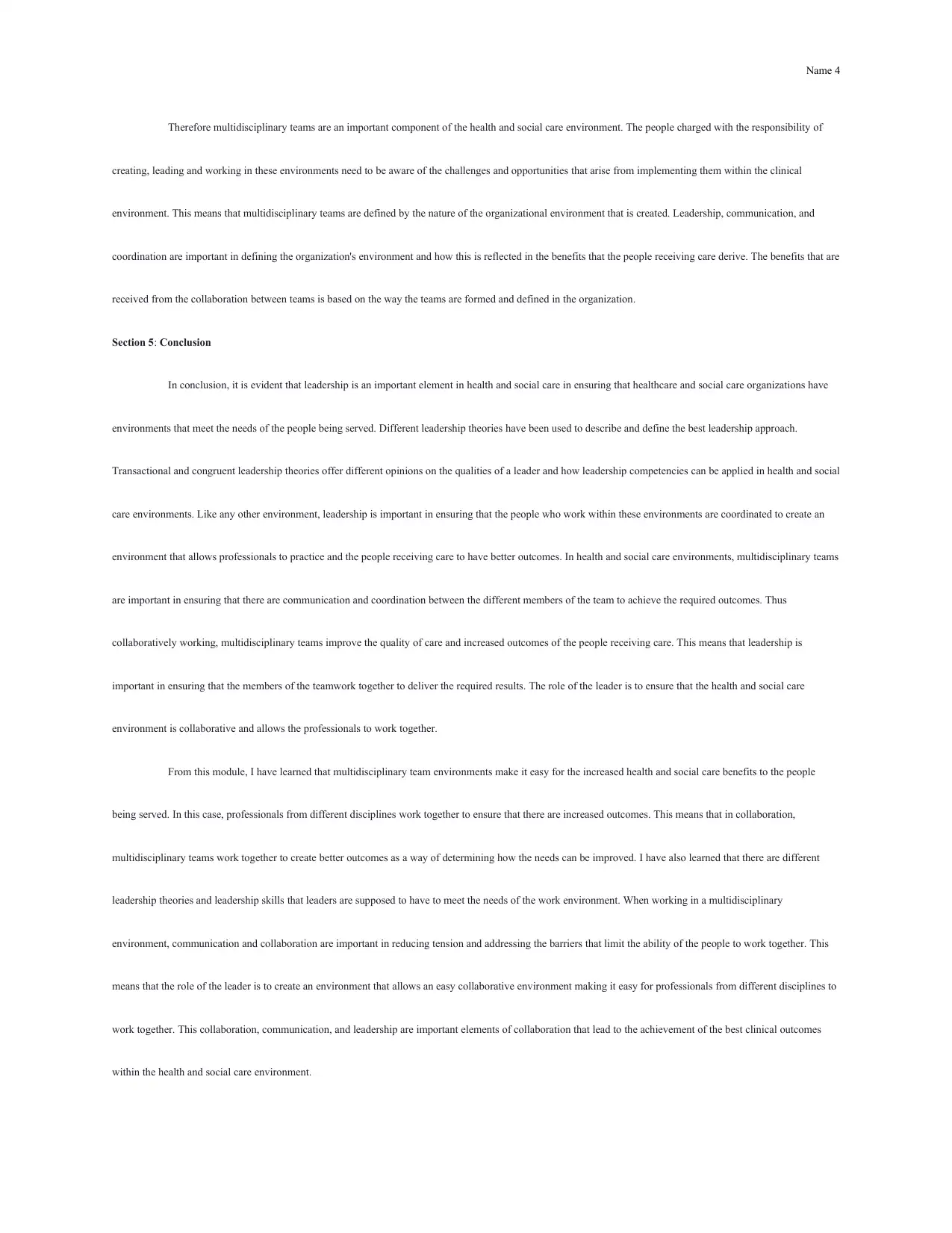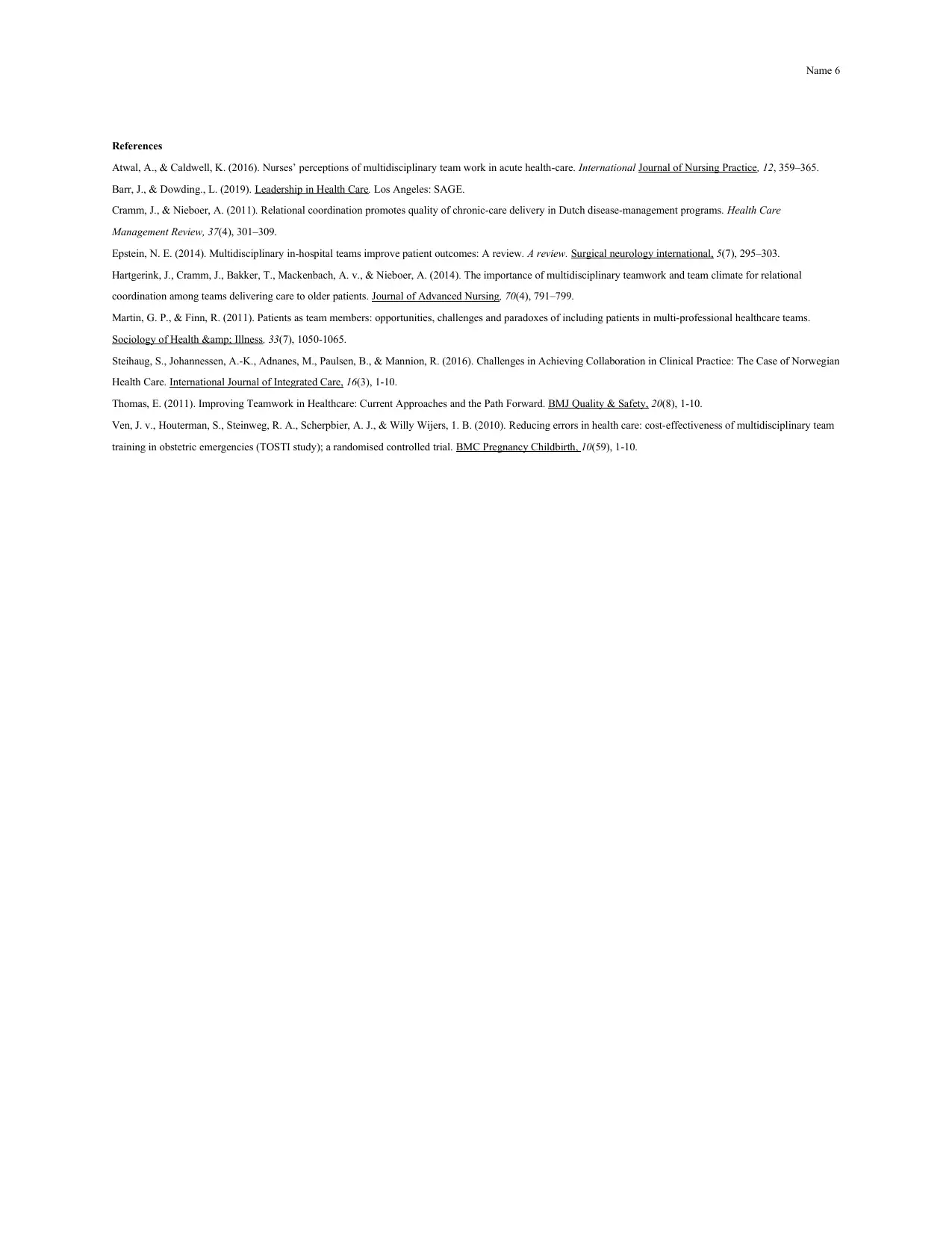Leadership and Teamwork Dynamics in Health and Social Care Settings
VerifiedAdded on 2022/10/06
|6
|2053
|14
Essay
AI Summary
This assignment critically discusses multidisciplinary teamwork within health and social care environments, emphasizing the importance of leadership. The essay explores how healthcare and social care settings rely on collaboration between professionals to meet patient needs. It defines multidisciplinary teams and their role in providing integrated care, particularly in response to changing patient demographics. The discussion highlights the benefits of increased coordination, communication, and patient safety, while acknowledging potential barriers such as organizational and individual challenges. The assignment examines the significance of clear purpose, institutional support, and team leadership in fostering a collaborative environment. It concludes by summarizing the importance of leadership, communication, and collaboration in achieving optimal clinical outcomes and reflects on key learning points, including different leadership theories and the role of leaders in fostering teamwork and addressing barriers within multidisciplinary settings. References are provided to support the arguments presented.

Name 1
Section 3 and Conclusion
Student’s Name
University
Date
Section 3 and Conclusion
Student’s Name
University
Date
Paraphrase This Document
Need a fresh take? Get an instant paraphrase of this document with our AI Paraphraser

Name 2
Section 3: Critically discuss multi-disciplinary teamwork in health and social care
Healthcare and social care by definition employ the practice of collaboration since they require professionals to work with each other to meet the needs of
the people that they serve. Healthcare and social care patients require services from different multidisciplinary teams within the clinical environment. Multidisciplinary
teams exist as a collaboration between different professionals who work together to achieve the required clinical needs of the patient or the client. This is defined as
two or more people interacting with a common purpose that is related to the needs of the client (Hartgerink, Cramm, Bakker, Mackenbach, & Nieboer 2014, p. 794).
Different patients require the skills and efforts of different professionals who work together in a multidisciplinary environment to achieve the needs of the patient. In
the clinical environment, multidisciplinary teams are used to provide integrated care due to the changing nature of diseases and conditions. As patient population
demographics keep on changing, integrated work environments the needs of patients have also become varied thus calling for the need to require the intervention of
multidisciplinary teams.
The role of multidisciplinary teams has been specifically attributed to the benefits of increased coordination and communication. Cramm & Nieboer (2011,
p. 305) suggests that this is seen in the improved performance of interdependent works within the clinical environment. This leads to increased efficiency that is created
through the relationships that professionals have with each other. For example by working closely with each other and knowing the role that each of them plays within
the organization there is increased ability to meet the complex needs of patients. The relations that teams have with each other are defined by the team climate created
through organizational processes that determine the way professional relationships with each other (Epstein 2014, p. 299). In this case, organizational culture is one of
the important elements in meeting the needs of the organization and defining how members relate with each other. In this case, the success of multidisciplinary teams is
related to the nature of the organization and structures that have been put in place to allow coordination and easy communication of different professionals within the
clinical environment. Communication and coordination define the way multidisciplinary teams work together to meet the needs of the people being assisted within the
care environment.
Multidisciplinary teams have also been defined by increased patient safety through reduced medical errors and increased patient safety. In most cases,
multi-disciplinary teams provide an environment that allows easy definition of the needs of each of the people being served. In multidisciplinary work environments,
there is high collaboration between the different healthcare professionals which increases the ability to follow the required standards thus reducing the likelihood of
errors. Thomas (2011) By collaboratively working together, patient safety is increased in the healthcare and social care environment since each of the members tries to
work to meet the needs of the person being served. Since collaboration and communication creates an environment that allows people to work together, the benefits are
Section 3: Critically discuss multi-disciplinary teamwork in health and social care
Healthcare and social care by definition employ the practice of collaboration since they require professionals to work with each other to meet the needs of
the people that they serve. Healthcare and social care patients require services from different multidisciplinary teams within the clinical environment. Multidisciplinary
teams exist as a collaboration between different professionals who work together to achieve the required clinical needs of the patient or the client. This is defined as
two or more people interacting with a common purpose that is related to the needs of the client (Hartgerink, Cramm, Bakker, Mackenbach, & Nieboer 2014, p. 794).
Different patients require the skills and efforts of different professionals who work together in a multidisciplinary environment to achieve the needs of the patient. In
the clinical environment, multidisciplinary teams are used to provide integrated care due to the changing nature of diseases and conditions. As patient population
demographics keep on changing, integrated work environments the needs of patients have also become varied thus calling for the need to require the intervention of
multidisciplinary teams.
The role of multidisciplinary teams has been specifically attributed to the benefits of increased coordination and communication. Cramm & Nieboer (2011,
p. 305) suggests that this is seen in the improved performance of interdependent works within the clinical environment. This leads to increased efficiency that is created
through the relationships that professionals have with each other. For example by working closely with each other and knowing the role that each of them plays within
the organization there is increased ability to meet the complex needs of patients. The relations that teams have with each other are defined by the team climate created
through organizational processes that determine the way professional relationships with each other (Epstein 2014, p. 299). In this case, organizational culture is one of
the important elements in meeting the needs of the organization and defining how members relate with each other. In this case, the success of multidisciplinary teams is
related to the nature of the organization and structures that have been put in place to allow coordination and easy communication of different professionals within the
clinical environment. Communication and coordination define the way multidisciplinary teams work together to meet the needs of the people being assisted within the
care environment.
Multidisciplinary teams have also been defined by increased patient safety through reduced medical errors and increased patient safety. In most cases,
multi-disciplinary teams provide an environment that allows easy definition of the needs of each of the people being served. In multidisciplinary work environments,
there is high collaboration between the different healthcare professionals which increases the ability to follow the required standards thus reducing the likelihood of
errors. Thomas (2011) By collaboratively working together, patient safety is increased in the healthcare and social care environment since each of the members tries to
work to meet the needs of the person being served. Since collaboration and communication creates an environment that allows people to work together, the benefits are

Name 3
reflected in the care process that people receive. Ven, Houterman, Steinweg, Scherpbier, & Willy Wijers (2010, p.6) argue that when professionals work together, there
are increased benefits that are derived from the patient in ensuring that professionals meet the needs of the organization. Medical errors arise when there are difficulties
in dealing with organizational needs to ensure that people work together to improve the environment that patients are served in.
Although multidisciplinary teams are defined by work flexibility, they do not automatically lead to communication and coordination among tasks. This
leads to tension between the professionals which in turn creates barriers to achieving the benefits of multidisciplinary teams. Martin & Finn (2011, p. 1059) suggests
that if a positive relationship is not fostered among the team members, it becomes difficult to meet the needs of the patients and clients and at the same time for the
members to work together. For example, there is a challenge in sharing of tasks and determining who should hold the decision making authority in a multidisciplinary
environment which trickles down to the failure to achieve the required quality of life. In most cases, multidisciplinary teams are supposed to have a high level of
communication and coordination to determine the way tasks are shared and distributed to each of the members of the team. This means that multidisciplinary teams do
not necessarily lead to the best outcomes in the clinical environment. There are organizational and individual barriers that create difficulties in achieving the benefits of
multidisciplinary teams.
Further, research has shown that for the organization to benefit from the multidisciplinary team environment, there are enablers that must be in place. The
first is the need to have a clear purpose which is defined by team members interacting with each other across professional and disciplinary boundaries. This is achieved
through team leadership that drives the members to achieve the desired patient goals (Barr & Dowding, 2019). For example, to work in such environments, the role of
the leader is to assist the members develop a care plan which will be used to set the goals that have to be achieved by each member of the team. Another important
element is institutional support to create a collaborative environment for the members of easily work with each other (Atwal & Caldwell, 2016). Then team leadership
is important for coordinating the activities and roles of the multidisciplinary team as a way of creating the best working environment. Steihaug, Johannessen, Adnanes,
Paulsen, & Mannion (2016, p. 4) add that for the members to work well with each other collaborative opportunities must be created through the creation of physical
space ad time for all the members to work and engage each other through an understanding of the roles that each one of them plays. This means that multidisciplinary
teams do not always lead to the best outcomes in the clinical environment due to the nature of the relationships that exist between the teams that are formed in the
clinical environment. In this case, multidisciplinary teams that can lead to difficulties in working with other members of the multidisciplinary team that affect the
outcome of clinical processes within the organization.
reflected in the care process that people receive. Ven, Houterman, Steinweg, Scherpbier, & Willy Wijers (2010, p.6) argue that when professionals work together, there
are increased benefits that are derived from the patient in ensuring that professionals meet the needs of the organization. Medical errors arise when there are difficulties
in dealing with organizational needs to ensure that people work together to improve the environment that patients are served in.
Although multidisciplinary teams are defined by work flexibility, they do not automatically lead to communication and coordination among tasks. This
leads to tension between the professionals which in turn creates barriers to achieving the benefits of multidisciplinary teams. Martin & Finn (2011, p. 1059) suggests
that if a positive relationship is not fostered among the team members, it becomes difficult to meet the needs of the patients and clients and at the same time for the
members to work together. For example, there is a challenge in sharing of tasks and determining who should hold the decision making authority in a multidisciplinary
environment which trickles down to the failure to achieve the required quality of life. In most cases, multidisciplinary teams are supposed to have a high level of
communication and coordination to determine the way tasks are shared and distributed to each of the members of the team. This means that multidisciplinary teams do
not necessarily lead to the best outcomes in the clinical environment. There are organizational and individual barriers that create difficulties in achieving the benefits of
multidisciplinary teams.
Further, research has shown that for the organization to benefit from the multidisciplinary team environment, there are enablers that must be in place. The
first is the need to have a clear purpose which is defined by team members interacting with each other across professional and disciplinary boundaries. This is achieved
through team leadership that drives the members to achieve the desired patient goals (Barr & Dowding, 2019). For example, to work in such environments, the role of
the leader is to assist the members develop a care plan which will be used to set the goals that have to be achieved by each member of the team. Another important
element is institutional support to create a collaborative environment for the members of easily work with each other (Atwal & Caldwell, 2016). Then team leadership
is important for coordinating the activities and roles of the multidisciplinary team as a way of creating the best working environment. Steihaug, Johannessen, Adnanes,
Paulsen, & Mannion (2016, p. 4) add that for the members to work well with each other collaborative opportunities must be created through the creation of physical
space ad time for all the members to work and engage each other through an understanding of the roles that each one of them plays. This means that multidisciplinary
teams do not always lead to the best outcomes in the clinical environment due to the nature of the relationships that exist between the teams that are formed in the
clinical environment. In this case, multidisciplinary teams that can lead to difficulties in working with other members of the multidisciplinary team that affect the
outcome of clinical processes within the organization.
⊘ This is a preview!⊘
Do you want full access?
Subscribe today to unlock all pages.

Trusted by 1+ million students worldwide

Name 4
Therefore multidisciplinary teams are an important component of the health and social care environment. The people charged with the responsibility of
creating, leading and working in these environments need to be aware of the challenges and opportunities that arise from implementing them within the clinical
environment. This means that multidisciplinary teams are defined by the nature of the organizational environment that is created. Leadership, communication, and
coordination are important in defining the organization's environment and how this is reflected in the benefits that the people receiving care derive. The benefits that are
received from the collaboration between teams is based on the way the teams are formed and defined in the organization.
Section 5: Conclusion
In conclusion, it is evident that leadership is an important element in health and social care in ensuring that healthcare and social care organizations have
environments that meet the needs of the people being served. Different leadership theories have been used to describe and define the best leadership approach.
Transactional and congruent leadership theories offer different opinions on the qualities of a leader and how leadership competencies can be applied in health and social
care environments. Like any other environment, leadership is important in ensuring that the people who work within these environments are coordinated to create an
environment that allows professionals to practice and the people receiving care to have better outcomes. In health and social care environments, multidisciplinary teams
are important in ensuring that there are communication and coordination between the different members of the team to achieve the required outcomes. Thus
collaboratively working, multidisciplinary teams improve the quality of care and increased outcomes of the people receiving care. This means that leadership is
important in ensuring that the members of the teamwork together to deliver the required results. The role of the leader is to ensure that the health and social care
environment is collaborative and allows the professionals to work together.
From this module, I have learned that multidisciplinary team environments make it easy for the increased health and social care benefits to the people
being served. In this case, professionals from different disciplines work together to ensure that there are increased outcomes. This means that in collaboration,
multidisciplinary teams work together to create better outcomes as a way of determining how the needs can be improved. I have also learned that there are different
leadership theories and leadership skills that leaders are supposed to have to meet the needs of the work environment. When working in a multidisciplinary
environment, communication and collaboration are important in reducing tension and addressing the barriers that limit the ability of the people to work together. This
means that the role of the leader is to create an environment that allows an easy collaborative environment making it easy for professionals from different disciplines to
work together. This collaboration, communication, and leadership are important elements of collaboration that lead to the achievement of the best clinical outcomes
within the health and social care environment.
Therefore multidisciplinary teams are an important component of the health and social care environment. The people charged with the responsibility of
creating, leading and working in these environments need to be aware of the challenges and opportunities that arise from implementing them within the clinical
environment. This means that multidisciplinary teams are defined by the nature of the organizational environment that is created. Leadership, communication, and
coordination are important in defining the organization's environment and how this is reflected in the benefits that the people receiving care derive. The benefits that are
received from the collaboration between teams is based on the way the teams are formed and defined in the organization.
Section 5: Conclusion
In conclusion, it is evident that leadership is an important element in health and social care in ensuring that healthcare and social care organizations have
environments that meet the needs of the people being served. Different leadership theories have been used to describe and define the best leadership approach.
Transactional and congruent leadership theories offer different opinions on the qualities of a leader and how leadership competencies can be applied in health and social
care environments. Like any other environment, leadership is important in ensuring that the people who work within these environments are coordinated to create an
environment that allows professionals to practice and the people receiving care to have better outcomes. In health and social care environments, multidisciplinary teams
are important in ensuring that there are communication and coordination between the different members of the team to achieve the required outcomes. Thus
collaboratively working, multidisciplinary teams improve the quality of care and increased outcomes of the people receiving care. This means that leadership is
important in ensuring that the members of the teamwork together to deliver the required results. The role of the leader is to ensure that the health and social care
environment is collaborative and allows the professionals to work together.
From this module, I have learned that multidisciplinary team environments make it easy for the increased health and social care benefits to the people
being served. In this case, professionals from different disciplines work together to ensure that there are increased outcomes. This means that in collaboration,
multidisciplinary teams work together to create better outcomes as a way of determining how the needs can be improved. I have also learned that there are different
leadership theories and leadership skills that leaders are supposed to have to meet the needs of the work environment. When working in a multidisciplinary
environment, communication and collaboration are important in reducing tension and addressing the barriers that limit the ability of the people to work together. This
means that the role of the leader is to create an environment that allows an easy collaborative environment making it easy for professionals from different disciplines to
work together. This collaboration, communication, and leadership are important elements of collaboration that lead to the achievement of the best clinical outcomes
within the health and social care environment.
Paraphrase This Document
Need a fresh take? Get an instant paraphrase of this document with our AI Paraphraser

Name 5

Name 6
References
Atwal, A., & Caldwell, K. (2016). Nurses’ perceptions of multidisciplinary team work in acute health-care. International Journal of Nursing Practice, 12, 359–365.
Barr, J., & Dowding., L. (2019). Leadership in Health Care. Los Angeles: SAGE.
Cramm, J., & Nieboer, A. (2011). Relational coordination promotes quality of chronic-care delivery in Dutch disease-management programs. Health Care
Management Review, 37(4), 301–309.
Epstein, N. E. (2014). Multidisciplinary in-hospital teams improve patient outcomes: A review. A review. Surgical neurology international, 5(7), 295–303.
Hartgerink, J., Cramm, J., Bakker, T., Mackenbach, A. v., & Nieboer, A. (2014). The importance of multidisciplinary teamwork and team climate for relational
coordination among teams delivering care to older patients. Journal of Advanced Nursing, 70(4), 791–799.
Martin, G. P., & Finn, R. (2011). Patients as team members: opportunities, challenges and paradoxes of including patients in multi‐professional healthcare teams.
Sociology of Health & Illness, 33(7), 1050-1065.
Steihaug, S., Johannessen, A.-K., Adnanes, M., Paulsen, B., & Mannion, R. (2016). Challenges in Achieving Collaboration in Clinical Practice: The Case of Norwegian
Health Care. International Journal of Integrated Care, 16(3), 1-10.
Thomas, E. (2011). Improving Teamwork in Healthcare: Current Approaches and the Path Forward. BMJ Quality & Safety, 20(8), 1-10.
Ven, J. v., Houterman, S., Steinweg, R. A., Scherpbier, A. J., & Willy Wijers, 1. B. (2010). Reducing errors in health care: cost-effectiveness of multidisciplinary team
training in obstetric emergencies (TOSTI study); a randomised controlled trial. BMC Pregnancy Childbirth, 10(59), 1-10.
References
Atwal, A., & Caldwell, K. (2016). Nurses’ perceptions of multidisciplinary team work in acute health-care. International Journal of Nursing Practice, 12, 359–365.
Barr, J., & Dowding., L. (2019). Leadership in Health Care. Los Angeles: SAGE.
Cramm, J., & Nieboer, A. (2011). Relational coordination promotes quality of chronic-care delivery in Dutch disease-management programs. Health Care
Management Review, 37(4), 301–309.
Epstein, N. E. (2014). Multidisciplinary in-hospital teams improve patient outcomes: A review. A review. Surgical neurology international, 5(7), 295–303.
Hartgerink, J., Cramm, J., Bakker, T., Mackenbach, A. v., & Nieboer, A. (2014). The importance of multidisciplinary teamwork and team climate for relational
coordination among teams delivering care to older patients. Journal of Advanced Nursing, 70(4), 791–799.
Martin, G. P., & Finn, R. (2011). Patients as team members: opportunities, challenges and paradoxes of including patients in multi‐professional healthcare teams.
Sociology of Health & Illness, 33(7), 1050-1065.
Steihaug, S., Johannessen, A.-K., Adnanes, M., Paulsen, B., & Mannion, R. (2016). Challenges in Achieving Collaboration in Clinical Practice: The Case of Norwegian
Health Care. International Journal of Integrated Care, 16(3), 1-10.
Thomas, E. (2011). Improving Teamwork in Healthcare: Current Approaches and the Path Forward. BMJ Quality & Safety, 20(8), 1-10.
Ven, J. v., Houterman, S., Steinweg, R. A., Scherpbier, A. J., & Willy Wijers, 1. B. (2010). Reducing errors in health care: cost-effectiveness of multidisciplinary team
training in obstetric emergencies (TOSTI study); a randomised controlled trial. BMC Pregnancy Childbirth, 10(59), 1-10.
⊘ This is a preview!⊘
Do you want full access?
Subscribe today to unlock all pages.

Trusted by 1+ million students worldwide
1 out of 6
Related Documents
Your All-in-One AI-Powered Toolkit for Academic Success.
+13062052269
info@desklib.com
Available 24*7 on WhatsApp / Email
![[object Object]](/_next/static/media/star-bottom.7253800d.svg)
Unlock your academic potential
Copyright © 2020–2025 A2Z Services. All Rights Reserved. Developed and managed by ZUCOL.





